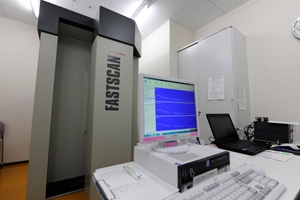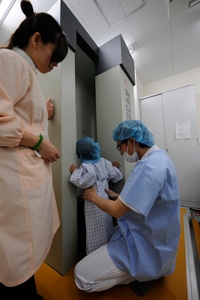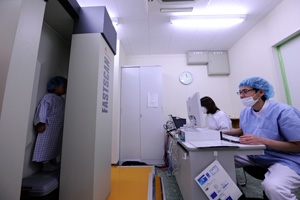Red Cross helps set minds at ease on radiation
2012/09/11

By Francis Markus in Fukushima
It’s a hot afternoon and despite the mothers’ best efforts, the children sitting at the tables in the Fukushima Red Cross hospital cafeteria are cranky, reading their comics, fidgeting and having low-intensity fights.
They’re waiting their turn to go in to the whole body scanner, which tests internal exposure to radiation.
(Photo: Whole Body Scan installed at the Fukushima Red Cross Hospital (c) Nobuyuki Kobayashi)
“Within a few years, we will have tested the whole population of Fukushima City,” says the chief radiologist in charge of the scanning, Hisamitsu Sato. Then, he says, they may decide to restart the testing process again.

I’m curious to hear whether he and his colleagues will really need to continue testing for a few years, given that the overwhelming majority of the results fall well short of the benchmarks of 180 becquerels for Cesium 134 and 200 becquerels of Cesium 137.
“The professionals from the Japan Atomic Energy Agency say it is needed because people continue to consume food, which may contain radiation, so we need to continue testing,” explains Mr. Sato.
(Photo: At the Fukushima Red Cross Hospital, staff say they’re working their way through all the city’s children by age group. They say that people have many concerns and questions about how much radiation they’ve been exposed too, although the results show very few readings that are significantly above normal levels. (c) Nobuyuki Kobayashi)
Local Red Cross officials say there is so far no information on any effects of the radiation, such as have been seen in the areas affected by the 1986 Chernobyl disaster, which include immune system problems and listlessness among children.
When I ask about possible testing for thyroid cancer, along the lines of the massive post-Chernobyl Red Cross Red Crescent programme, they tell me that this is an issue which will need to be determined several years down the line.

Interestingly, even much of the radiation testing now being carried out here is being done on the initiative of local authorities, without reference to the prefectural government, which has yet to issue decisions, said Mr. Sato.
(Photo: The data obtained from these radiation scans not only serve as a source of information and reassurance, but they are also a potentially useful resource in case of similar incidents, faced by any other National Society in the future.(c) Nobuyuki Kobayashi )
But the significance of the testing that’s going on here, next to the cafeteria, as the children wait their turn, isn’t only for their immediate health. It’s also a matter of collecting data which could be relevant anywhere else in the world should a similar nuclear accident occur.
The staff at the hospital is keen to point out what they say is the high quality of the data being collected by their unit. As regards the other two scanners in the city, “ says hospital director Masahiro Furukawa . “ one of them is installed in a mobile unit, so the readings collected by the one in this hospital are the most stable.”
Of course those in charge of the other units may have their own view on that. But the issue of gathering the lessons and experience from Fukushima is a high priority, both for the Japanese Red Cross and the IFRC. They are exploring, together with other interested member Red Cross Red Crescent National Societies the option of establishing a reference centre on nuclear disaster preparedness, following a consultation meeting held in Tokyo in May.
“Listening to the people in Fukushima who were in the frontline of the disaster will be a crucial part of that,” says Hiroto Oyama from the Japanese Red Cross president’s office, who is a member of the task force driving JRCS’ work to build on the lessons of Fukushima.















